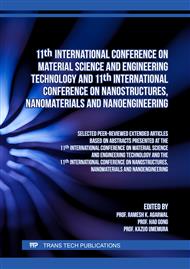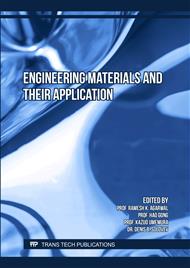[1]
B. P. Calabia, F. Ninomiya, H. Yagi, A. Oishi, K. Taguchi, M. Kunioka, and M. Funabashi, "Biodegradable poly (butylene succinate) composites reinforced by cotton fiber with silane coupling agent," Polymers, vol. 5, no. 1, pp.128-141, 2013.
DOI: 10.3390/polym5010128
Google Scholar
[2]
Y. Zhao, J. Qu, Y. Feng, Z. Wu, F. Chen, and H. Tang, "Mechanical and thermal properties of epoxidized soybean oil plasticized polybutylene succinate blends," Polymers for Advanced Technologies, vol. 23, no. 3, pp.632-638, 2012.
DOI: 10.1002/pat.1937
Google Scholar
[3]
H. Liu, Z. Huang, J. Qu, and C. Meng, "The effect of epoxidized soybean oil on mechanical and rheological properties of poly (butylene succinate)/lignin via vane extruder." p.120001.
DOI: 10.1063/1.4942316
Google Scholar
[4]
P. Liminana, L. Quiles-Carrillo, T. Boronat, R. Balart, and N. Montanes, "The Effect of Varying Almond Shell Flour (ASF) Loading in Composites with Poly (Butylene Succinate (PBS) Matrix Compatibilized with Maleinized Linseed Oil (MLO)," Materials, vol. 11, no. 11, p.2179, 2018.
DOI: 10.3390/ma11112179
Google Scholar
[5]
G. L. Robertson, Food packaging: principles and practice: CRC press, 2016.
Google Scholar
[6]
D. Parra, J. Fusaro, F. Gaboardi, and D. Rosa, "Influence of poly (ethylene glycol) on the thermal, mechanical, morphological, physical–chemical and biodegradation properties of poly (3-hydroxybutyrate)," Polymer degradation and stability, vol. 91, no. 9, pp.1954-1959, 2006.
DOI: 10.1016/j.polymdegradstab.2006.02.008
Google Scholar
[7]
M. Râpă, R. DARIE-NIŢĂ, E. Grosu, E. TĂNASE, A. Trifoi, T. PAPa, and C. Vasile, "Effect of plasticizers on melt processability and properties of PHB," Journal of Optoelectronics and Advanced Materials, vol. 17, no. 11-12, pp.1778-1784, 2015.
Google Scholar
[8]
G. Farris, P. Cinelli, I. Anguillesi, S. Salvadori, M.-B. Coltelli, and A. Lazzeri, "Effect of ageing time on mechanical properties of plasticized poly (hydroxybutyrate)(PHB)." pp.294-297.
DOI: 10.1063/1.4876836
Google Scholar
[9]
M. Baiardo, G. Frisoni, M. Scandola, M. Rimelen, D. Lips, K. Ruffieux, and E. Wintermantel, "Thermal and mechanical properties of plasticized poly (L‐lactic acid)," Journal of Applied Polymer Science, vol. 90, no. 7, pp.1731-1738, 2003.
DOI: 10.1002/app.12549
Google Scholar
[10]
M. Murariu, A. Da Silva Ferreira, M. Alexandre, and P. Dubois, "Polylactide (PLA) designed with desired end‐use properties: 1. PLA compositions with low molecular weight ester‐like plasticizers and related performances," Polymers for Advanced Technologies, vol. 19, no. 6, pp.636-646, 2008.
DOI: 10.1002/pat.1131
Google Scholar
[11]
Y. Lemmouchi, M. Murariu, A. M. Dos Santos, A. J. Amass, E. Schacht, and P. Dubois, "Plasticization of poly (lactide) with blends of tributyl citrate and low molecular weight poly (D, L-lactide)-b-poly (ethylene glycol) copolymers," European Polymer Journal, vol. 45, no. 10, pp.2839-2848, 2009.
DOI: 10.1016/j.eurpolymj.2009.07.006
Google Scholar
[12]
M. P. Arrieta, J. López, A. Hernández, and E. Rayón, "Ternary PLA–PHB–Limonene blends intended for biodegradable food packaging applications," European Polymer Journal, vol. 50, pp.255-270, 2014.
DOI: 10.1016/j.eurpolymj.2013.11.009
Google Scholar
[13]
M. P. Arrieta, M. D. Samper, J. López, and A. Jiménez, "Combined effect of poly (hydroxybutyrate) and plasticizers on polylactic acid properties for film intended for food packaging," Journal of Polymers and the Environment, vol. 22, no. 4, pp.460-470, 2014.
DOI: 10.1007/s10924-014-0654-y
Google Scholar
[14]
L. Rosario, and E. Dell, "AC 2010-593: BIODEGRADABILITY OF PLASTICS TESTING IN AN UNDERGRADUATE MATERIALS LABORATORY COURSE," age, vol. 15, p.1, 2010.
DOI: 10.18260/1-2--16014
Google Scholar
[15]
M. Rapa, R. Darie-Nita, and C. Vasile, "Influence of plasticizers over some physico-chemical properties of PLA," Materiale Plastice, vol. 54, no. 1, pp.73-78, 2017.
DOI: 10.37358/mp.17.1.4789
Google Scholar
[16]
P. Jantrawut, T. Chaiwarit, K. Jantanasakulwong, C. H. Brachais, and O. Chambin, "Effect of plasticizer type on tensile property and in vitro indomethacin release of thin films based on low-methoxyl pectin," Polymers, vol. 9, no. 7, p.289, 2017.
DOI: 10.3390/polym9070289
Google Scholar
[17]
D. Tapia-Blácido, P. do Amaral Sobral, and F. Menegalli, "Effect of drying conditions and plasticizer type on some physical and mechanical properties of amaranth flour films," LWT-Food Science and Technology, vol. 50, no. 2, pp.392-400, 2013.
DOI: 10.1016/j.lwt.2012.09.008
Google Scholar
[18]
A. Chaos, A. Sangroniz, A. Gonzalez, M. Iriarte, J. R. Sarasua, J. del Río, and A. Etxeberria, "Tributyl citrate as an effective plasticizer for biodegradable polymers: effect of plasticizer on free volume and transport and mechanical properties," Polymer International, vol. 68, no. 1, pp.125-133, 2019.
DOI: 10.1002/pi.5705
Google Scholar
[19]
C. Courgneau, S. Domenek, A. Guinault, L. Avérous, and V. Ducruet, "Analysis of the structure-properties relationships of different multiphase systems based on plasticized poly (lactic acid)," Journal of Polymers and the Environment, vol. 19, no. 2, pp.362-371, 2011.
DOI: 10.1007/s10924-011-0285-5
Google Scholar
[20]
M. Bocqué, C. Voirin, V. Lapinte, S. Caillol, and J. J. Robin, "Petro‐based and bio‐based plasticizers: Chemical structures to plasticizing properties," Journal of Polymer Science Part A: Polymer Chemistry, vol. 54, no. 1, pp.11-33, 2016.
DOI: 10.1002/pola.27917
Google Scholar
[21]
J. Ahn, W.-J. Chung, I. Pinnau, and M. D. Guiver, "Polysulfone/silica nanoparticle mixed-matrix membranes for gas separation," Journal of Membrane science, vol. 314, no. 1-2, pp.123-133, 2008.
DOI: 10.1016/j.memsci.2008.01.031
Google Scholar
[22]
J. Greene, "A Review of biodegradation of biodegradable plastics under industrial compost, marine, soil, and anaerobic digestion," Journal of Bioremediation & Biodegradation, no. 2017, 20/10/2017, 2017.
Google Scholar
[23]
M. G. A. Vieira, M. A. da Silva, L. O. dos Santos, and M. M. Beppu, "Natural-based plasticizers and biopolymer films: A review," European Polymer Journal, vol. 47, no. 3, pp.254-263, 2011.
DOI: 10.1016/j.eurpolymj.2010.12.011
Google Scholar
[24]
J. Greene, "Biodegradation of biodegradable and compostable plastics under industrial compost, marine and anaerobic digestion," Ecology, Pollution and Environmental Science, 2018.
Google Scholar
[25]
X. Qi, Y. Ren, and X. Wang, "New advances in the biodegradation of Poly (lactic) acid," International Biodeterioration & Biodegradation, vol. 117, pp.215-223, 2017.
DOI: 10.1016/j.ibiod.2017.01.010
Google Scholar
[26]
M. Itävaara, S. Karjomaa, and J.-F. Selin, "Biodegradation of polylactide in aerobic and anaerobic thermophilic conditions," Chemosphere, vol. 46, no. 6, pp.879-885, 2002.
DOI: 10.1016/s0045-6535(01)00163-1
Google Scholar



